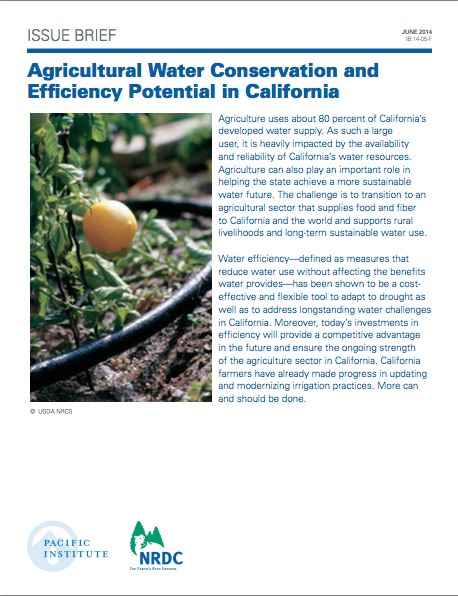Overview
California’s agricultural production is the largest in the United States, and uses about 80 percent of the state’s developed water supply. As such a large water user, wide-scale implementation of water conservation and efficiency measures in the agricultural sector is key to achieving a more sustainable water future for California. While farmers have made progress in improving irrigation technology and practices, this report asserts that more can and should be done.
The report finds that water efficiency–defined as measures that reduce water use without affecting the benefits that water provides–has the potential to reduce agricultural water use by up to 22%. The authors recommend investments and shifts towards more efficient irrigation techniques. Some of the conserved water could be redirected to other consumptive uses, such as drinking water in urban areas. Water efficiency measures also help reduce vulnerability to drought and other unpredictable conditions.
Conservation and efficiency potential was calculated based on implementation of the following techniques:
- Irrigation technology: shifting nearly 1.1 million acres of land currently irrigated by flood to drip and 2.2 million acres of land irrigated by flood to sprinklers;
- Irrigation scheduling: expanding to all farms the application of irrigation scheduling, using local climate and soil information to determine crop water requirements.
- Regulated deficit irrigation: applying less water to all wine grape, raisin, almond, and pistachio acreage during drought-tolerant growth stages to save water and improve crop quality.
Key Findings
Key findings include:
- California’s agricultural water use could be reduced by 5.6-6.6 million acre-feet per year, or 17-22%, while maintaining productivity and total acreage irrigated.
- Part of these savings are reductions in consumptive use, ranging from 0.6 million to 2 million acre-feet per year, which represents additional supply that can be allocated to other beneficial uses. The rest of the savings reflect a reduction in water withdrawn from rivers, streams, and groundwater, with improvements in water quality, instream flow, and energy savings, among other benefits.
- In addition to reducing water use, efficiency improvements can increase crop yield and quality while reducing input costs, resulting in higher profits.
- While all practices produced considerable water savings, the greatest savings were associated with better irrigation scheduling: 2.7 to 3.6 million acre-feet per year.
- Due to a shift toward higher-value crops and the increased adoption of more efficient irrigation technologies and practice, the economic productivity of water has exceeded $700 per acre-foot in every year since 2003 (over an average of $420 per acre-foot in the 1960s and averages consistently below $700 per acre-foot in the 1970s and 1980s).
- The authors did not examine the full technical efficiency potential (e.g., a scenario in which all farmers use drip irrigation), but used assumptions consistent with a more rapid uptake of proven efficiency measures.
- The authors did not distinguish between reductions in consumptive and nonconsumptive use due to data limitations, but there is evidence that significant consumptive savings are possible, especially with regulated deficit irrigation.
- Adopting regulated deficit irrigation on California’s entire wine grape, almond, and pistachio acreage would reduce consumptive use by 1.1 million acre-feet per year. The other practices analyzed would also result in consumptive use reductions.
In this Series


